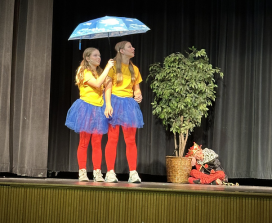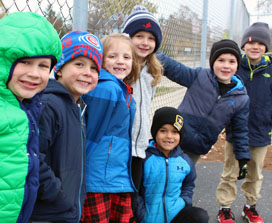New Therapy Dog Program
We are excited to announce that we will be beginning a therapy dog program at Pacelli Catholic High School! A similar program has been run at the PCS Elementary Schools for the last four years. Here is a little bit of information about our program:
We will be working with Piper. She is a 6 year old mixed breed dog, an AKC Canine Good Citizen, and a trained/ advanced certified therapy dog registered through K9-5 National Therapy Dog Registry. To obtain these titles and certifications, Piper had to complete extensive training and rigorous testing.
 Piper will be working primarily with students in Learning Resource Lab and in ESL classes. She will be utilized as a motivational tool, a stress reducing presence, and a resource for language acquisition. Piper will be typically be working at Pacelli once a week and primarily in the learning resource room (Room 118). Piper will remain on leash when outside the classroom.
Piper will be working primarily with students in Learning Resource Lab and in ESL classes. She will be utilized as a motivational tool, a stress reducing presence, and a resource for language acquisition. Piper will be typically be working at Pacelli once a week and primarily in the learning resource room (Room 118). Piper will remain on leash when outside the classroom.
Mrs. Nerren and Mr. Theiss are coordinating with our school nurse to address any severe allergies. Before Piper comes into the school, she will be cleaned and brushed to significantly reduce dander. Physical contact with the therapy dog is always optional. Students with any contact allergies to dogs that wish to participate, should wash their hands before and after working with Piper.
Research has shown that therapy dogs assist learning in the following ways:
- foster childrens’ natural tendency to open up (Jalongo, Astorino and Bomboy, 2004);
- assist in creating a more and the stress-free environment;
- help children develop logical reasoning skills, understand biological principles, and make abstract concepts more concrete (Anderson, 2007);
- encourage children to successfully complete more complicated academic activities across the curriculum when participating in animal assisted therapies (Anderson, 2007);
- help students to maintain focus and build motivation, even when other interventions fail (Anderson, 2007);
- can reduce stress, bring blood pressure and heart rate to normal levels, and can eliminate other observable signs of anxiety (Jalongo, 2005);
- help to curb off-task/distracted behavior;
- beneficial for children experiencing challenges with comprehension, literacy, concentration, and in overcoming learning difficulties such as Attention Deficit Hyperactivity Disorder, Conduct Disorder and Autism (Sorin, 2012);
- help students to improve in their social and emotional skills both inside and outside of the classroom, by easing loneliness, fostering trust, and improving communication(Dunlap, 2010)
Please contact Mrs. Michelle Nerren (mnerren@pacellicatholicschools.com) or Mr. Larry Theiss (ltheiss@pacellicatholicschools.com) with any questions!
Sources
Anderson, K. (2007). Who let the dog In? How to incorporate a dog into a self-contained classroom. Teaching Exceptional Children Plus, 4(1), 1-17. Retrieved January 31, 2015, from http://files.eric.ed.gov/fulltext/EJ967469.pdf
Dunlap, V. M. (2010, May 28). CANINE ASSISTED THERAPY AND REMEDIATING READING: A REVIEW OF LITERATURE. Retrieved January 31, 2015, from https://www.nmu.edu/sites/DrupalEducation/files/UserFiles/Files/Pre-Drupal/SiteSections/Stude nts/GradPapers/EdSpecialist/Dunlap_Vicki_EP.pdf
Jalongo, Renck, M. (2005, April 01). “WHAT ARE ALL THESE DOGS DOING AT SCHOOL?”: Using Therapy Dogs To Promote Children’s Reading Practice. Childhood Education, (3), 152, Retrieved from http://elibrary.bigchalk.com
Sorin, R. (2012). “I do writing on Monday so I can read to the dog” – The impact of the CLASSROOM CANINES program on young children’s literacy learning. 8th International Conference on Education, 8(July 2012), 563-568. Retrieved January 31, 2015, from http://works.bepress.com/cgi/viewcontent.cgi?article=1061&context=reesa_sorin&sei-redir=1 &referer=http://www.google.com/url?q=http%3A%2F%2Fworks.bepress.com%2Fcgi%2Fvie wcontent.cgi%3Farticle%3D1061%26context%3Dreesa_sorin&s









































Leave a Comment